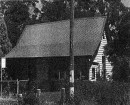Back to search results
NEW FEDERAL MILL
UPPER YARRA WALKING TRACK ADA, BAW BAW SHIRE
NEW FEDERAL MILL
UPPER YARRA WALKING TRACK ADA, BAW BAW SHIRE
All information on this page is maintained by Heritage Victoria.
Click below for their website and contact details.
Victorian Heritage Register
-
Add to tour
You must log in to do that.
-
Share
-
Shortlist place
You must log in to do that.
- Download report

1 new federal mill ada valley piedmont outlet tram jul1998

On this page:
Statement of Significance
What is significant?
The New Federal Mill is a large and multi-faceted sawmill site, with evidence of logging, milling, timber transport and workers’ accommodation. The mill was operated by the Federal Timber Company from 1935-1949, and was connected by an outlet tramway to the railhead at Warburton via Starling Gap. The site features substantial remains of the mill shed including concrete, timber and brick machinery foundations, timber tramways on log supports, and iron cabling. Remnant roof posts indicate the size of the mill shed, while three tall tree spars which originally supported a water tank are still standing. Numerous large tree stumps around the site indicate the size of Mountain Ash trees originally logged. The mill dugout is collapsed but its size and purpose as a bushfire refuge are clearly demonstrated. The brick, stone, iron and timber remains of numerous domestic buildings are also located around the site, demonstrating the separation of the mill community into areas for single men and families. The outlet tramway is a comparatively intact example of its kind, with substantial bridge remains, earth cuttings and sleepers in situ.
How is it significant?
The New Federal Mill is of historical and archaeological significance to the State of Victoria.
Why is it significant?
The New Federal Mill is archaeologically important for the relative intactness of its remains, which provide evidence of the scale, structure and functioning of a steam-powered sawmill, which operated in Victoria’s premier logging district of the early twentieth century. Domestic artefacts from the site also have the potential to provide evidence relating to the cultural history of sawmilling settlements.
The New Federal Mill is historically significant for its associations with manager Jack Corbett, a French Canadian responsible for introducing into Victoria large-scale North American logging methods such as ‘skylines’, high lead winches and multi-drum ‘Washington’ winches. The New Federal Mill is also historically significant as a mill which produced barrel staves, an unusual form of the timber industry
The New Federal Mill is a large and multi-faceted sawmill site, with evidence of logging, milling, timber transport and workers’ accommodation. The mill was operated by the Federal Timber Company from 1935-1949, and was connected by an outlet tramway to the railhead at Warburton via Starling Gap. The site features substantial remains of the mill shed including concrete, timber and brick machinery foundations, timber tramways on log supports, and iron cabling. Remnant roof posts indicate the size of the mill shed, while three tall tree spars which originally supported a water tank are still standing. Numerous large tree stumps around the site indicate the size of Mountain Ash trees originally logged. The mill dugout is collapsed but its size and purpose as a bushfire refuge are clearly demonstrated. The brick, stone, iron and timber remains of numerous domestic buildings are also located around the site, demonstrating the separation of the mill community into areas for single men and families. The outlet tramway is a comparatively intact example of its kind, with substantial bridge remains, earth cuttings and sleepers in situ.
How is it significant?
The New Federal Mill is of historical and archaeological significance to the State of Victoria.
Why is it significant?
The New Federal Mill is archaeologically important for the relative intactness of its remains, which provide evidence of the scale, structure and functioning of a steam-powered sawmill, which operated in Victoria’s premier logging district of the early twentieth century. Domestic artefacts from the site also have the potential to provide evidence relating to the cultural history of sawmilling settlements.
The New Federal Mill is historically significant for its associations with manager Jack Corbett, a French Canadian responsible for introducing into Victoria large-scale North American logging methods such as ‘skylines’, high lead winches and multi-drum ‘Washington’ winches. The New Federal Mill is also historically significant as a mill which produced barrel staves, an unusual form of the timber industry
Show more
Show less
-
-
NEW FEDERAL MILL - Permit Exemptions
General Exemptions:General exemptions apply to all places and objects included in the Victorian Heritage Register (VHR). General exemptions have been designed to allow everyday activities, maintenance and changes to your property, which don’t harm its cultural heritage significance, to proceed without the need to obtain approvals under the Heritage Act 2017.Places of worship: In some circumstances, you can alter a place of worship to accommodate religious practices without a permit, but you must notify the Executive Director of Heritage Victoria before you start the works or activities at least 20 business days before the works or activities are to commence.Subdivision/consolidation: Permit exemptions exist for some subdivisions and consolidations. If the subdivision or consolidation is in accordance with a planning permit granted under Part 4 of the Planning and Environment Act 1987 and the application for the planning permit was referred to the Executive Director of Heritage Victoria as a determining referral authority, a permit is not required.Specific exemptions may also apply to your registered place or object. If applicable, these are listed below. Specific exemptions are tailored to the conservation and management needs of an individual registered place or object and set out works and activities that are exempt from the requirements of a permit. Specific exemptions prevail if they conflict with general exemptions. Find out more about heritage permit exemptions here.Specific Exemptions:General Conditions:
1. All exempted alterations are to be planned and carried out in a manner which prevents damage to the fabric of the registered place or object.
2. Should it become apparent during further inspection or the carrying out of alterations that original or previously hidden or inaccessible details of the place or object are revealed which relate to the significance of the place or object, then the exemption covering such alteration shall cease and the Executive Director shall be notified as soon as possible.
3. If there is a conservation policy and plan approved by the Executive Director, all works shall be in accordance with it.
4. Nothing in this declaration prevents the Executive Director from amending or rescinding all or any of the permit exemptions.
5. Nothing in this declaration exempts owners or their agents from the responsibility to seek relevant planning or building permits from the responsible authority where applicable.
Exemptions:
* fire suppression
* public safety
* land care maintenance
* erosion and salinity control
* weed and vermin control
-
-
-
-
-
NEW ADA MILL
 Victorian Heritage Register H1820
Victorian Heritage Register H1820 -
NEW ADA INCLINE
 Victorian Heritage Inventory
Victorian Heritage Inventory -
NEW ADA MILL
 Victorian Heritage Inventory
Victorian Heritage Inventory
-
1 Fordham Court
 Yarra City
Yarra City -
10 Fordham Court
 Yarra City
Yarra City
-
-











